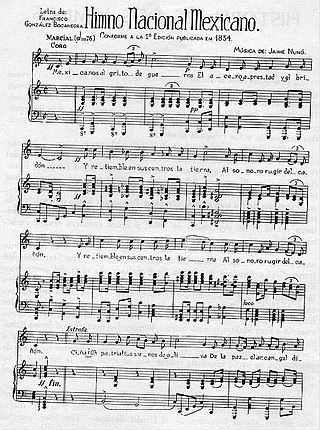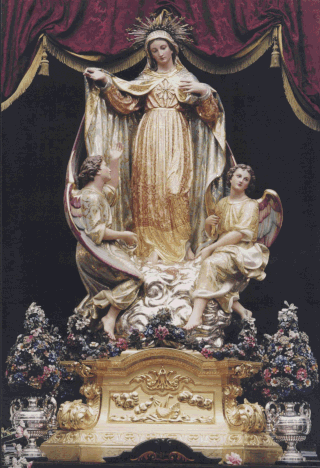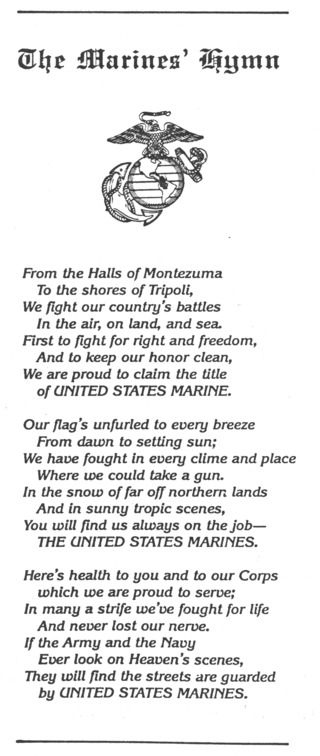

Salve Marinera is the official anthem of the Spanish Navy. Its meaning can be loosely translated as "Salutation of the seas" or "Praise song of the seas".


Salve Marinera is the official anthem of the Spanish Navy. Its meaning can be loosely translated as "Salutation of the seas" or "Praise song of the seas".
The Salve Marinera lyrics and music originated in the zarzuela "El Molinero de Subiza", by Cristóbal Oudrid in 1870. The lyrics of this hymn, written by Mariano Méndez Vigo, [1] are exalting the Virgin Mary as Stella Maris (Our Lady, Star of the Sea). It was adopted by the Spanish Navy as its official anthem towards the end of the 19th century, at an uncertain date.
With the passing of the time this anthem has become very popular in nautical theme celebrations throughout coastal areas in Spain. It is sung as one of the highlights of Our Lady of Mount Carmel yearly commemorational festivities by fishermen on July 16. [2] [3] Mostly the singing of the Salve Marinera takes place after a procession carrying the Virgin's image to the church. [4] [5]
Despite its popularity in Catalonia [6] and Galicia, the Salve Marinera has only a Castilian Spanish version; it does not exist in any of the other languages of Spain. The present music accompanying the hymn was adapted in 1942 by Jesús Montalbán Vizcón, then director of the Spanish Navy's training facilities' musical band (Banda de Música de la Escuela Naval). [1]
| Salve Marinera | |
| Praise song of the seas | |
| ¡Salve! Estrella de los mares, | Hail! Star of the seas, |
| de los mares iris, de eterna ventura. | Of the gleaming seas, of eternal blessing. |
| ¡Salve! Oh Fénix de hermosura, | Hail! Oh Phoenix of beauty, |
| Madre del Divino Amor. | Mother of the Divine Love |
| De tu pueblo, a los pesares | From your people, to their sorrows |
| Tu clemencia dé consuelo | May your mercy give comfort |
| Fervoroso llegue al Cielo | Fervently arrive at heaven |
| y hasta Ti, y hasta Ti nuestro clamor | And unto you, and unto you our cries |
| ¡Salve! ¡Salve! Estrella de los mares | Hail, hail! Star of the ocean, |
| ¡Salve! Estrella de los mares | Hail! Star of the seas |
| Sí, fervoroso llegue al Cielo | Indeed, fervently arrive at heaven |
| y hasta Ti, y hasta Ti nuestro clamor | And unto you, and unto you our cries |
| ¡Salve! ¡Salve! Estrella de los mares | Hail, hail! Star of the ocean, |
| ¡Salve! ¡Salve! ¡Salve! Salve! | Hail! Hail! Hail! Hail! |
An anthem is a musical composition of celebration, usually used as a symbol for a distinct group, particularly the national anthems of countries. Originally, and in music theory and religious contexts, it also refers more particularly to short sacred choral work and still more particularly to a specific form of liturgical music. In this sense, its use began c. 1550 in English-speaking churches; it uses English language words, in contrast to the originally Roman Catholic 'motet' which sets a Latin text.

The "Mexican National Anthem", also known by its incipit "Mexicans, at the cry of war", is the national anthem of Mexico. The lyrics of the national anthem, which allude to historical Mexican military victories in the heat of battle and including cries of defending the homeland, were composed by poet Francisco González Bocanegra after a Federal contest in 1853. Later, in 1854, he asked Jaime Nunó to compose the music that now accompanies González's poem. The national anthem, consisting of ten stanzas and a chorus, effectively entered into use on September 16, 1854.
A national anthem is a patriotic musical composition symbolizing and evoking eulogies of the history and traditions of a country or nation. The majority of national anthems are marches or hymns in style. American, Central Asian, and European nations tend towards more ornate and operatic pieces, while those in the Middle East, Oceania, Africa, and the Caribbean use a more simplistic fanfare. Some countries that are devolved into multiple constituent states have their own official musical compositions for them ; their constituencies' songs are sometimes referred to as national anthems even though they are not sovereign states.
"¡Salve, Oh Patria!" is the national anthem of Ecuador. The lyrics were written in 1865 by poet Juan León Mera, under request of the Ecuadorian Senate; the music was composed by Antonio Neumane. However, it was not officially adopted by the Congress until September 29, 1948.

The "Himno Nacional de Uruguay", also known by its incipit "Orientales, la Patria o la Tumba", is the longest national anthem in terms of duration with 105 bars of music. When performed in its entirety, the anthem lasts about four-and-a-half to six minutes, although nowadays only the first verse and chorus are sung on most occasions, such as before sporting events.

"Ave maris stella" is a medieval Marian hymn, usually sung at Vespers. It was especially popular in the Middle Ages and has been used by many composers, as the basis of other compositions.

The "Salve Regina", also known as the "Hail Holy Queen", is a Marian hymn and one of four Marian antiphons sung at different seasons within the Christian liturgical calendar of the Catholic Church. The Salve Regina is traditionally sung at Compline in the time from the Saturday before Trinity Sunday until the Friday before the first Sunday of Advent. The Hail Holy Queen is also the final prayer of the Rosary.

Marian hymns are Christian songs focused on Mary, mother of Jesus. They are used in both devotional and liturgical services, particularly by the Roman Catholic, Eastern Orthodox, Oriental Orthodox, Anglican, and Lutheran churches. They are often used in the month of May devotions. Some have also been adopted as Christmas hymns. Marian hymns are not popular among some Protestants, as they see Marian veneration as idolatry. However, the practice is very common among Christians of Catholic traditions, and a key component of the Eastern Orthodox liturgy. There are many more hymns to Mary within the Eastern Orthodox yearly cycle of liturgy than in Roman Catholic liturgy.

Our Lady of Mount Carmel, or Virgin of Carmel, is the title given to the Blessed Virgin Mary in her role as patroness of the Carmelite Order, particularly within the Catholic Church. The first Carmelites were Christian hermits living on Mount Carmel in the Holy Land during the late 12th and early to mid-13th century. They built in the midst of their hermitages a chapel which they dedicated to the Blessed Virgin, whom they conceived of in chivalric terms as the "Lady of the place." Our Lady of Mount Carmel was adopted in the 19th century as the patron saint of Chile.

The Marine Infantry is the naval infantry branch of the Spanish Navy responsible for conducting amphibious warfare. Fully integrated into the Spanish Navy's structure, the branch's history dates back to 1537 when Charles V, Holy Roman Emperor formed the Compañías Viejas del Mar de Nápoles, making it the oldest marine unit in existence.
Stella Maris may refer to:

Our Lady, Star of the Sea is an ancient title for Mary, the mother of Jesus. The words Star of the Sea are a translation of the Latin title Stella Maris.

Mary, the mother of Jesus in Christianity, is known by many different titles, epithets, invocations, and several names associated with places.

Víctor Larco Herrera also called commonly Víctor Larco is a district and a city of the north coast of Peru. It is located on a plain along the Pacific Ocean and is linked by a conurbation with Trujillo in La Libertad region. It is considered one of the 9 districts of the urban area known as Trujillo Metropolitano, one of the most populous metropolitan areas of Peru; it is also one of the 11 districts of Trujillo province. Victor Larco is the district that has the highest human development index (HDI) out of Lima Metropolitana, according to a study published by the United Nations Development Programme. In the early twentieth century, for its mild climate and fresh, it was known as Buenos Aires and then in 1945 got the name of Victor Larco Herrera in memory of the illustrious philanthropist Trujillan who was a benefactor of the city.

The veneration of Mary in the Catholic Church encompasses various devotions which include prayer, pious acts, visual arts, poetry, and music devoted to her. Popes have encouraged it, while also taking steps to reform some manifestations of it. The Holy See has insisted on the importance of distinguishing "true from false devotion, and authentic doctrine from its deformations by excess or defect". There are significantly more titles, feasts, and venerative Marian practices among Roman Catholics than in other Western Christian traditions. The term hyperdulia indicates the special veneration due to Mary, greater than the ordinary dulia for other saints, but utterly unlike the latria due only to God.

Our Lady of Navigators also known as Our Lady of Seafarers is a devotional title given to the Virgin Mary by Roman Catholics. It is a widespread devotion in South America, especially in Brazil, where her holy day is celebrated on 2 February, it is an official holiday on the city of Porto Alegre. Several churches in Brazil are dedicated to Our Lady of Navigators.

Our Lady of Europe is a title given to the Blessed Virgin Mary as patroness of Gibraltar and protectress of Europe. The entire European continent was consecrated under the protection of Our Lady of Europe in the early 14th century from the Shrine in Gibraltar where devotion continues to this day, over 700 years on.

The "Marines' Hymn" is the official hymn of the United States Marine Corps, introduced by the first director of the USMC Band, Francesco Maria Scala. Its music originates from an 1867 work by Jacques Offenbach with the lyrics added by an anonymous author at an unknown time in the following years. Authorized by the Commandant of the Marine Corps in 1929, it is the oldest official song in the United States Armed Forces. The "Marines' Hymn" is typically sung at the position of attention as a gesture of respect, akin to a national anthem. However, the third verse is also used as a toast during formal events, such as the birthday ball and other ceremonies.

Manuel Fernández Juncos was a Spanish-born, Puerto Rican journalist, poet, author and humanitarian who wrote the official lyrics to La Borinqueña, Puerto Rico's official anthem.